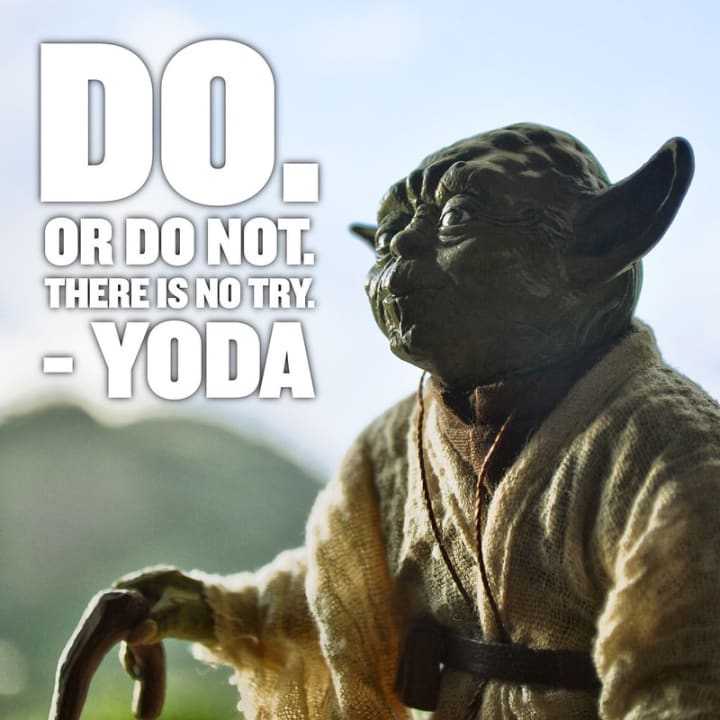“And Do What?”: Why These Should Be the Three Most Important Words in Your Life and Career
Great advice on how to manage your work, your workers, your relationships, and yes, basically, your life in just three short words

Introduction: Two Magic Words - “It Depends!”
One thing is for certain. Ask any consultant - usually loosened up after a few beers - what their “go-to” move is, and more than likely, you will hear what can be the several thousands of dollars - or much, much more - worth of wisdom that companies will pay highly for today. Every consultant has an area of expertise. Otherwise, what would they consult about (now no, we all know that doesn’t stop some people, now does it?).
True confession. I am now a generalist when it comes to consulting. But once, not so long ago, I was known as “Mr. Reverse Auctions.” Reverse auctions were my “go-to” move in the 2000’s and 2010’s!
If you are involved in purchasing or procurement for organizations or are one who makes his/her living in industrial/institutional sales, then you know what a reverse auction is. Otherwise, the other 90% of you likely have no idea - and that’s okay (no, it’s not eBay!). To this day, if you Google “reverse auctions,” you will likely see my name on the first page of the search results. For a time a decade or more ago when every large company and every government agency was looking to employ reverse auctioning, I was a “hot commodity” in the consulting trade, thanks largely to both “word of mouth” and yes, “Mr. Google!” Tech gurus and mathematicians were selling their wares as reverse auction experts, but I became regarded as one of the few folks on the planet who could talk and help organizations with the “nuts and bolts” of actually implementing, managing, and navigating reverse auctions - as a buyer or as a seller. I helped the Department of Defense to yes, save money on military procurements (not an oxymoron!). I did the same sort of work with, other government agencies at the federal and state levels and companies, both large and small, to work with reverse auctions as buyers and sellers. Yes, it was a good time to be in the Wyld biz, but health problems with my parents slowed down my ability to consult in the pre-Zoom age when most of consulting and speaking had to be done in person and on the road!

But now, as reverse auctions have lost some of their luster and become "just another tool" in the purchasing and selling “toolbox” for organizations, and yes, I have also become a professor “of a certain age,” I am more of a laid-back consultant these days, working with only select clients and organizations and doing speaking engagements when asked (yes, call me!). However, one of my constant “go-to” moves is nothing more than two words: “It depends!” It depends is the hallmark of what is known as the contingency theory of management, which, in a nutshell, holds that all management is situational and that the “right” action to take in a given situation should be based on the circumstances. So, most good managers manage based on the situation at hand, rather than relying simply on hard and fast rules, policies, procedures, and guidelines. So, what’s the right answer or best solution to any management quandry, any management issue or problem? Well, it comes down to two magic words: “It depends…” Now Venmo me my consulting fee - thank you very much!

The New Three Big, Small Words: “And Do What?”
Now, as one who espouses lifelong learning and continuous improvement as not just buzzwords, but things that one should constantly and actively engage in throughout your life and career, I keep my eyes open for inspiration from any source for my management consulting work and my university teaching. And my latest revelation in terms of seeking good management advice to share in my consulting, writing, and teaching came from what many of my Ph.D.-holding colleagues in the academy would - in academic terms - simply “poo poo!” But as a management expert, I think this simple management advice - three whole words in length - is as wise and important as anything you could read in the Harvard Business Review or any best-selling management or leadership book.

We are presently in the late stages of the National Football League (NFL) season here in the month of December, and as a pro football fan, I listen to a number of sports podcasts as I work, as I walk, and yes, honestly, in simply trying to get to sleep! Yes, I am drawn to podcasts that focus on the business aspects of sports - all sports and the media that covers them. I listen to podcasts such as Nothing Personal with David Samson (the former President of the Miami Marlins) and seek out episodes of other sports podcasts when they have sports and sports media executives on them.
Perhaps my favorite new sports podcast that occupies at least one of my hour-plus walks each week is called “What the Football?” (catchy, eh?). It is hosted by two female sports innovators: Suzy Shuster, who is a pioneering sports broadcaster, and Amy Trask, who is a pioneering NFL executive - the first female to head a pro football team - the Oakland/Los Angeles/Las Vegas Raiders with over 30 years of experience in the league. Their podcast not only deals with the action on the field but also the action happening in terms of the business of football and the media coverage of the sport. And so each week, both women are able to give very insightful commentary on the sports - and sports business - news of the day.
Now, the intent of this article is not an infomercial for Suzy Shuster and Amy Trask’s podcast (though I do think that you should check it out!). Rather, my purpose is to shine the spotlight on and memorialize what I think is as good management advice as one can get - perhaps even better than the tried and true two words - “it depends” - that encapsulate and operationalize the contingency theory of management. No, in this article, we will look at a new rule of management, one that Amy Trask highlighted in a recent episode of “What the Football?” that literally made me stop in my walking tracks and take note of its wisdom and power. And in reading this article, I hope that you will now employ these three words - “And Do What?” - as part of your toolbox as you deal with not only situations in your work career but in life itself!

The Origins of “And Do What?”
As stated previously, Amy Trask had a 30-year career in the NFL, all with the Raiders franchise. She worked for the then-owner of the Raiders, the legendary “Prince of Darkness” Al Davis.
Al Davis is in the Pro Football Hall of Fame, and is the only person in the history of the NFL, and in fact, in American pro sports, to serve as a:
(1) A player personnel assistant,
(2) An assistant coach,
(3) A head coach,
(4) A team’s general manager,
(5) A league commissioner, and
(6) The principal owner and chief executive officer of an NFL team.
Amy Trask is widely regarded as a trailblazer and a role model for women in the sports business, having worked her way up from an internship in 1983 to becoming CEO of the team. She relishes - and embraces - the nickname that she earned from working for the “Prince of Darkness” in Davis, as she became known as “The Princess of Darkness.”
Now, for those of you who aren’t NFL scholars, the famous - or infamous - firing of Lane Kiffin (yes, him - the now successful head coach at Ole Miss) was now 15 years ago. This incident is commonly known in football lore as the “overhead projector firing.” In a 2008 press conference, Al Davis lived up to his nickname in firing Kiffin as his team’s head coach. He did so with the help of an overhead projector - long after that device was the de facto choice for projecting information on a screen for an audience - which he used to make his case for firing Kiffin for cause - and thus, for not paying him the balance of millions and millions of dollars on his contract!
So, it’s now 2023, and Al’s son, Mark Davis, the owner of the now Las Vegas Raiders, was considering firing his head coach, Josh McDaniels, due to the team’s poor performance and turmoil in the locker room. As rumors swirled about McDaniel’s fate this fall, Suzy Shuster interviewed Amy Trask on the “What the Football” podcast. Together, they reminisced about the circumstances of the 2008 then-Oakland Raiders’ firing of Lane Kiifin and the infamous overhead projector press conference. Trask explained how that time gave birth to what she deemed to be the “And Do What?” Rule. Where does this phrase come from, and what does it mean? I’ll let Amy Trask explain it to you as I heard her explain it on her podcast a short time back:
And so in this context, as Trask so deftly explained, firing a team’s head coach is one thing. The question is whether you have a plan for what to do after the coach has to clean out his office. This is where the “And Do What?” question is so very important. According to Trask, if you don’t have a plan for what to do after the decision is made to take action, and if by taking the action, you will be worse off than just maintaining the status quo, then you really would be well advised to not take such a “rash” action.
Going back to Al Davis and the 2008 press conference, that became one of the, if not the touchstone of his Hall of Fame career, and that people remembered as one of his final acts as an owner much more than his groundbreaking antitrust battles with the NFL over where his team would play, his innovations on the field, his building of the Raider’s unique “Just Win Baby” team ethos and culture that brought them fans from all over the country and the world, and oh yeah, the Super Bowls that his Raiders team won under his - and Amy Trask’s - tenure with the team. As a staff writer for ESPN put it the next day, “The silver and black came out of Tuesday black and blue.” And yes, to this day, the Raiders franchise has had a continuing series of seeming missteps when it comes to coaching hires under the Davis’ regime, from Jon Gruden (who was fired for inappropriate emails) to now, Josh McDaniels, who was indeed fired earlier this season (and the team immediately went on a 2-game win streak and “looked like a new team” after McDaniels' dismissal!). “And Do What?” seems to be working out pretty well then, so far, for the Las Vegas Raiders with the coaching change.

Applying the “And Do What?” Rule to Your Own Career - and Your Life
Why do I think that Trask’s “And Do What?” rule is so important today? As a management consultant, I have seen far too many times where executives make what is - no doubt - an important, tough, and sometimes even controversial and contentious action. It might be a bit impulsive. It might even be one that could be said to be courageous. And yet, by making the decision that it’s “go time” and actually taking action, managing - whether that be one, two, three or a whole team of top decision-makers, means that, by definition, there will be repercussions from that managerial action - full stop!
In business, in sports, and yes, in life, you don’t just simply make a decision on something and take an action and then be able to sit back and say: “Whew! We’re done! Glad that’s over!” No, that action will have consequences - some good, some not-so-good, and yes, there could be some baaaaaaaaaad consequences as well.

In my “day job,” I deal with college students. By definition, college students aren’t always the best at making decisions. “And Do What?” is not something that gets thought about when you are 19, 20, or 21 at what can be some very crucial times in your life, even if you don’t know it at the time! Poor decisions - at times - are “baked into the cake” when it comes to young people. The key is whether they can come back from them, whether that be in a day, a week, or even years. Every semester, I seem to a few students who seem to “drop off the planet,” but I also have a number of students who “rally,” from illness, from family and/or personal issues, from depression or other mental concerns, and even from legal “issues,” to end-up doing well for themselves in my classes. “Well” can be pulling their grade up to an “A” or a “B” after a rough patch - or “patches” - during the semester. “Well” can also be simply doing good enough to pass the class with either a “C” or a “D” and avoiding failing and having to retake the course.

I am also so very pleased when I have a non-traditional student, who had to drop out of college the first time (for whatever reason) and now is coming back to school, working full-time and often with a family - and at 30, or 35, or 40, or even older, come into my class and simply “knock it out of the park!” To a person, when I speak with such students, they talk about how much better their mindset is as a student later in life, as opposed to when they were “yutes.” These non-traditional students also often serve as role models and confidants, and yes, sometimes when the age gap is 10-15-20 years - or more - they can turn into not just good friends with their fellow students, but serve as kind of a “surrogate Mom or Dad” for their traditional peers.

“And Do What?”
The three words here are very important, as the three-word sequence represents really a flow chart of what you - as an executive, a supervisor, a student, a teacher, or just in your everyday role as a human being - need to be prepared to do when you take an action of any consequence. And we are not talking about just things like hiring/firing employees, ending a relationship, or dropping out of college for the semester, we’re talking about many routine - and not-so-routine - actions that you might take, even throughout your workday.
The power of this three-word sequence is in the sequence - as it should spark a thought process in you in regards to both:
(A) What will be the “follow-on” from your decision, and are you/can you effectively prepared for the aftermath - however big or small that may indeed be - of your action; and
(B) Whether you want to really make that decision, given your analysis of the “And Do What?” question.
Let’s work through the three words - the three stages, if you will, of “And Do What?”

“And”
This is fundamental - and yes, should go without saying, but it needs to be! Know that the decisions you make and the actions you take will have consequences. Each decision has a “ripple” effect like the stone hitting the pond. And so, that action that you take will produce consequences, it will draw reactions, even from those who are not directly involved in the situation, and there will be - and need to be follow-on decisions and subsequent actions.
And do remember the Al Davis story, for while his is extreme as “The Prince of Darkness,” every decision you make is a part of your managerial legacy. And in your personal life, those decisions build not only your own character but perhaps even more importantly, your reputation. And who wants to be known for their worst decision…

Source: Flickr, https://www.flickr.com/photos/keepitsurreal/27278649900 (Used with permission)
“Do”
This is the trigger point in the decision-making process. This is when you have to make the “go or no go” call, hopefully based on a good analysis of not just the precursor to the situation, but also the aftermath and follow-on of that action that you considered in the “And” stage of this three-step sequence. The “Do” stage means simply that you must do something. And with any situation, doing nothing is always an option in the decision-making process.
Paradoxically then, owing to Yoda’s famous axiom of “Do or do not. There is no try!” doing nothing is okay! However, you must realize that stasis is indeed a decision! That call to say, in effect, “Nah, I’m good,” that too can have consequences - and reactions - and follow-on. So, the first step in the “Do” phase is yes, “Do or do not.” However, as Amy Trask so eloquently and concisely framed it, you have to first decide whether it is better to take an action (i.e. fire the coach) or leave things be (i.e. accept the status quo and leave the coach in place). Then, whether you a firing an NFL coach or one of your employees, you need to be prepared for the fallout that is sure to come. And in your own career (i.e. to take the job - or not) and life (i.e. to propose to your girlfriend/boyfriend - or not), know that to do can also mean to do not, and that is a decision that will have consequences as well for you, both immediate and yes, down the road.

“What”
This is the final stage of the “And Do What?” This represents the specific course of action that you decide to take after you make whatever decision you have come to in the prior two stages of this sequence. Yes, there could always be alternatives (and yes, as we just covered, doing nothing is one alternative course of action - or inaction - as the case may be). So, is the decision that you have reached the best, most optimal course of action? Why so? Can you - if need be - articulate the reasons/rationale for your action/choices, or is it - Oh God, here comes that term - a gut reaction! And no, one never, ever, ever really knows - or could know unless he or she was God himself/herself, whether any decision will be the right decision or not - and yes, some might question God on those things at times, too.
So, you have to make the decision that is best for you - and for what you believe is best for the situation and for all that will be - or can be - impacted by the action that you take based on that choice. Will you know if it is the “right” decision - immediately or even down the line? The answer is unquestionably “no.” However, you need to make a decision with which you can be comfortable, which you can defend if need be, and which you can live with for the next hour, the next day, the next week, and the next month, and yes, perhaps for your entire career.
No pressure here, but our careers are dotted with such individual, seemingly discrete decision-making situations that, taken together, do form our managerial resume - our “track record,” if you will. The same goes for us on a personal level as well.
And so, you would be well-advised to, as you go to answer the “And Do What?” question, think for a minute or two about how your course of action will help build - or harm - your own reputation and standing with those around you. And yes today, no one’s reputation stays in a small circle anymore, and so you need to be comfortable with how this one decision “log” will fit - or not fit - with the “stack of firewood” that is basically your reputation and your resume as a manager and your regard as a person. If it fits, then “just do it!” But if it doesn’t, then perhaps the “And Do What?” question can be looked upon as saving your arrrrsssss from making a rash decision, a bad call, or even a career- and/or relationship/friendship-ending decision in haste and/or in error.

Conclusion
The bottom line is this: You need to start using the “And Do What?” model. “And Do What?” consists of just three small words. But let there be no doubt in the substantial power and influence that these three words can have in making you a better manager, a better leader, and yes, a better colleague. And if you apply these three small - yet very big - words in your life outside of work as well, you will become a better person because you make better, more thoughtful, and well-thought-out decisions in your relationships and friendships. I want to thank “The Princess of Darkness,” Amy Trask, as should you (https://www.instagram.com/officialamytrask/), for giving us a new, highly useful management axiom to add to our professional and personal toolkits. I believe, and after going through the “And Do What?” process in deciding to share this concept with you in this article, that these three words - these twelve characters (including the necessary question mark) can make you not just a better manager or even a colleague, but a better person as well! So, remember “Do or do not. There is no try!” - and that there are consequences for both that you really need to consider before you step out on that limb that is basically life in the now mid-2020s!

++++++++++++++++++++++++++++++++
About David C. Wyld
David C. Wyld is a Professor of Strategic Management at Southeastern Louisiana University in Hammond, Louisiana. He is a management consultant, researcher/writer, publisher, executive educator, and experienced expert witness. You can view all of his work at https://authory.com/DavidWyld. You can subscribe to his Medium article feed at: https://davidwyld.medium.com/subscribe.
Social Media Links to David Wyld:
* on Facebook
* on LinkedIn
* on Threads
* on Twitter (X)
About the Creator
David Wyld
Professor, Consultant, Doer. Founder/Publisher of The IDEA Publishing (http://www.theideapublishing.com/) & Modern Business Press (http://www.modernbusinesspress.com)
Enjoyed the story? Support the Creator.
Subscribe for free to receive all their stories in your feed. You could also become a paid subscriber, letting them know you appreciate their work.






Comments (1)
Love the axiom and your conclusion!!!🥰